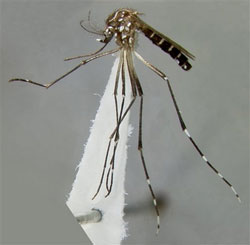Agencies work on DNA 'barcodes' database
(Agencies)
Updated: 2007-09-15 14:32
Updated: 2007-09-15 14:32
Washington - To help shoppers avoid mislabeled toxic pufferfish and pilots steer clear of birds, federal agencies are starting to tap into an ambitious project that is gathering DNA "barcodes" for the Earth's 1.8 million known species.
A consortium of scientists from almost 50 nations is overseeing the building of a global database made from tiny pieces of genetic material. Called DNA barcoding, the process takes a scientist only a few hours in a lab and about $2 to identify a species from a tissue sample or other piece of genetic material.
David Schindel, a Smithsonian Institution paleontologist and executive secretary of the Consortium for the Barcode of Life, said the purpose is to create a global reference library - "a kind of telephone directory for all species."
"If I know that gene sequence, I can submit it as a query to a database and get back the telephone number," he said. "I can get back the species name."
The government's interest in the project stems from a variety of possible uses.
The US Food and Drug Administration has begun eyeing it as a tool to ferret out hazardous fish species and to confirm a type of leech used in some surgery.
The Federal Aviation Administration and Air Force hope it will help them identify birds prone to collide with aircraft. The National Oceanic and Atmospheric Administration sees it as a means to track commercial fish and reduce killing of unwanted species also caught by nets.
A growing collection of feathers and other remains of birds that collided with planes has provided "operational" information for the FAA, said Scott Miller, a scientist at the Smithsonian Institution who chairs the consortium's executive committee.
"They have an almost complete reference database for the North American bird species," Miller said. "It is a routine tool that they use."
Elsewhere, the Environmental Protection Agency is testing species barcoding to identify insects and other invertebrates that indicate how healthy rivers and streams are. The Agriculture Department is contributing genetic data it has compiled on fruit flies in an effort help farmers control pests.
Among the agencies experimenting with the database, EPA has found that as it grows in size it is becoming "more and more useful as a practical tool for identifying species," EPA spokeswoman Jessica Emond said.
Scientists call it barcodes to compare it to the supermarket scanner codes that are indecipherable except to machines. But with plants and animals, the scanners look at the specific order of the four basic building blocks of DNA to identify the species.
Users gain free access to a repository of archival genetic material run jointly by US, European and Japanese facilities.
About 30,000 species have been logged in the database so far, but scientists hope to reach 500,000 within five years. A two-year goal is to have sequenced 2,800 - or about 80 percent of the 3,500 different species of mosquitoes.
Yvonne-Marie Linton of the Natural History Museum in London, said efforts to reduce mosquito populations blamed for up to 500 million human malaria cases and 1 million annual deaths each year are consistently hindered by misidentifying the species responsible.
Linton, who heads a project to barcode the mosquito species, said correctly identifying and controlling those carriers of malaria and other mosquito-borne illnesses like dengue fever and the West Nile virus are the "key to disease management."
Miller said barcoding is "basically going to revolutionize the way that mosquito survey and monitoring is done."
The consortium is sponsored by the Smithsonian Institution's Museum of Natural History. It grew out of 2003 research paper in which geneticist Paul Hebert at the University of Guelph in Ontario, Canada, proposed a database of DNA barcodes for identifying all species. Now, the Smithsonian and university share in the barcoding work.
|
|
|
||
|
||
|
|
|
|
